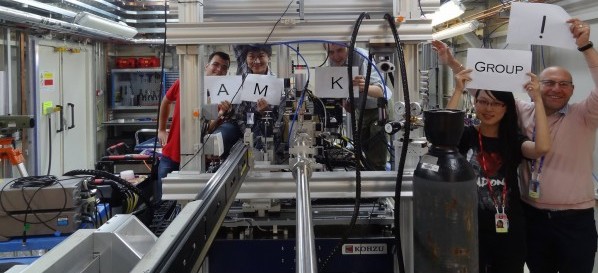Congratulations to group members who recently defended their DPhil vivas!
Nikolaos Baimpas
‘Hybrid’ non-destructive imaging techniques for engineering materials applications
Abstract:
The combination of X-ray imaging and diffraction techniques provides a unique tool for structural and mechanical analysis of engineering components. A variety of modes can be employed in terms of the spatial resolution (length-scale), time resolution (frequency), and the nature of the physical quantity being interrogated. This thesis describes my contributions towards the development of novel X-ray ‘rich’ imaging experimental techniques and data interpretation. The experimental findings have been validated via comparison with other experimental methods and numerical modelling.The combination of fast acquisition rate and high penetration properties of X-ray beams allows the collection of high-resolution 3-D tomographic data sets at submicron resolution during in situ deformation experiments. Digital Volume Correlation analysis tools developed in this study help understand crack propagation mechanisms in quasi-brittle materials and elasto-plastic deformation in co-sprayed composites. For the cases of crystalline specimens where the knowledge of “live” or residual elastic strain distributions is required, diffraction techniques have been advanced. Diffraction Strain Tomography (DST) allows non-destructive reconstruction of the 2-D (in-plane) variation of the out-of-plane strain component. Another diffraction modality dubbed Laue Orientation Tomography (LOT), a grain mapping approach has been proposed and developed based on the translate-rotate tomographic acquisition strategy. It allows the reconstruction of grain shape and orientation within polycrystalline samples, and provides information about intragranular lattice strain and distortion. The implications of this method have been thoroughly investigated. State-of-the-art engineering characterisation techniques evolve towards scrutinising submicron scale structural features and strain variation using the complementarity of X-ray imaging and diffraction. The first successful feasibility study is reported of in operando stress analysis in an internal combustion engine. Finally, further advancement of ‘rich’ imaging techniques is illustrated via the first successful application of Time-of-Flight Neutron Diffraction Strain (TOF-NDST) tomography for non-destructive reconstruction of the complete strain tensor using an inverse eigenstrain formulation.
Mengyin Xie
Abstract:
The thesis reports improvements in the characterization techniques for stress and texture in crystalline materials by x-ray and neutron powder diffraction. Furthermore, advances are made in texture evolution modelling and validation against experimental observations.
In the beginning, the fundamental assumption of diffraction strain analysis is numerically examined and verified, namely, that the lattice parameter value determined from fitting the diffraction pattern is equal to the average lattice parameter within the gauge volume.
Next, the task of shear strain determination from powder diffraction measurements is addressed. A method is developed and implemented for the complete 2D strain tensor determination from the multi-directional energy-dispersive x-ray diffraction patterns. The method not only offers a way to evaluate the shear strain, but also provides a better overall strain averaging approach.
Rotation and translation of sample and/or detectors in powder diffraction mode can effectively increase the pole figure coverage and thus the accuracy of texture determination.
However, the movements also introduce uncertainties and aberrations into data analysis due to the changes in the diffraction volume and transmitted intensity. In order to overcome these problems, accurate single exposure texture characterization techniques are proposed based on several different powder diffraction setups. Numerical analyses are carried out to prove that any simple texture in cubic polycrystals can be effectively determined using single exposure Debye-Scherrer diffraction pattern analysis. Several experiments are reported on collecting Debye-Scherrer diffraction patterns, multi-directional energy-dispersive x-ray diffraction patterns and multi-directional TOF neutron setup. Efficient data processing procedures of the diffraction patterns for ODF determination are presented.
Crystal plasticity finite element models are developed to model the texture evolution in polycrystalline engineering samples during manufacturing. In the present thesis, quantitative measures extracted from orientation distribution function are employed to make precise comparison between the model and experiment. Unlike the simple uni-axial compression and tension considered in the literature, in the present thesis the complex texture evolution during linear friction welding is modelled as a sequence of different shear deformations.
Tan Sui
Thermal-mechanical behaviour of the hierarchical structure of human dental tissue
Abstract:
Human dental tissues are fascinating nano-structured hierarchical materials that combine organic and mineral phases in an intricate and ingenious way to obtain remarkable combinations of mechanical strength, thermal endurance, wear resistance and chemical stability. Attempts to imitate and emulate this performance have been made since time immemorial, in order to provide replacement (e.g. in dental prosthodontics) or to develop artificial materials with similar characteristics (e.g. light armour). The key objectives of the present project are to understand the structure-property relationships that underlie the integrity of natural materials, human dental tissues in particular, and the multi-scale architecture of mineralized tissues and its evolution under thermal treatment and mechanical loading. The final objective is to derive ideas for designing and manufacturing novel artificial materials serving biomimetic purposes.
The objectives are achieved using the combination of a range of characterization techniques, with particular attention paid to the synchrotron X-ray scattering and imaging techniques, as well as microscopy techniques. Mechanical properties were characterized by nanoindentation and photoelasticity; and thermal analysis was carried out via thermogravimetric analysis (TGA). Experimental observations were critically examined and matched by advanced numerical simulation of the tissue under thermal-mechanical loading.
Four principal types of experiment were used to examine the thermal and mechanical behaviour of the hierarchical structure of human dental tissue and contributed to the Chapters of this thesis. The results presented in this thesis benefit the fundamental understanding of the structure-property integrity mechanisms of natural materials, human dental tissues in particular. These results were reported in several first-author publications in peer-reviewed journals, conference proceedings, and a book chapter.




